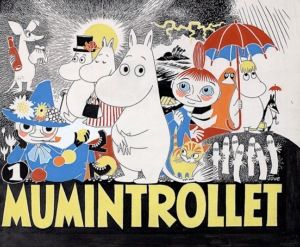Although known to most people as the creator of the magical fantasy universe of Moominland, the exhibition of Tove Jansson’s work at Kunstforeningen has been arranged to give equal weight to her work as an artist.
And very impressive her paintings are. One large room at the exhibition is devoted to them. There are several pictures of the family – which was extremely important to her – as well as a number of self-portraits in styles ranging from surrealism to modernism and the more lyrical style of her later years.
An early starter
Jansson was born in 1914 in a bohemian environment, with a sculptor father and a mother who worked as a graphic artist to supplement the family income. She was a precocious child and started formal art studies at the age of 16 in Stockholm.
In 1934 she went to Paris for the first time and was very struck by the impressionist works she saw there. She also went to Brittany, where she painted ‘Blue Hyacinth’, and to Italy – on the very brink of war.
Savage political satirist
World War II came as a nasty shock and Jannson, who held pacifist views, supplied political cartoons to the satirical magazine Garm. In one of them, Hitler is portrayed as a spoilt baby having a tantrum who can only be placated by being offered ‘more cake’ (see below).

She also made fun of Stalin as well, disliking all forms of dictatorship. A primitive version of the Moomin figure makes its first appearance as a sort of signature to some of the cartoons.
Writing the Moomin books provided Jansson with a way of coping with the anxiety caused by the conflict. The series would eventually comprise eight books about the peace-loving, philosophical family.
Fame and overwork
Fame and fortune came thanks to an English newspaper, the Evening News. Jansson was commissioned to draw six strips a week for seven years. Launched with an impressive advertising campaign, the strip was so successful that it eventually ran in 120 papers worldwide and was seen by 12 million readers.
One entire floor of the exhibition is devoted to the Moomin world. There are many preliminary sketches as well as the finished strips, so anyone with a fondness for all things Moomin will not be disappointed.

However, partly due to the extreme workload and personally answering thousands of fan letters, Jansson began to feel trapped by her own creation. In a revealing moment in one of the strips, Moomin says: “I only want to live in peace, plant potatoes and dream,” which certainly sounds like a cry for help. The pressure was taken off to some degree by her younger brother Lars, who took over the strip from 1961 up until it finished in 1975.
A number of Jansson’s illustrations for literary classics are also on display –amongst them are several from ‘The Hobbit’, ‘Alice In Wonderland’ and ‘The Hunting of the Snark’.
A celebration of diversity and tolerance
Whether she likes it or not, Jansson will always be primarily associated in the public eye with the loveable, complex, hippopotamus-like figures.
However, the message of the books and strips, which celebrated her own belief in human diversity and tolerance, is not the worst legacy to leave.














